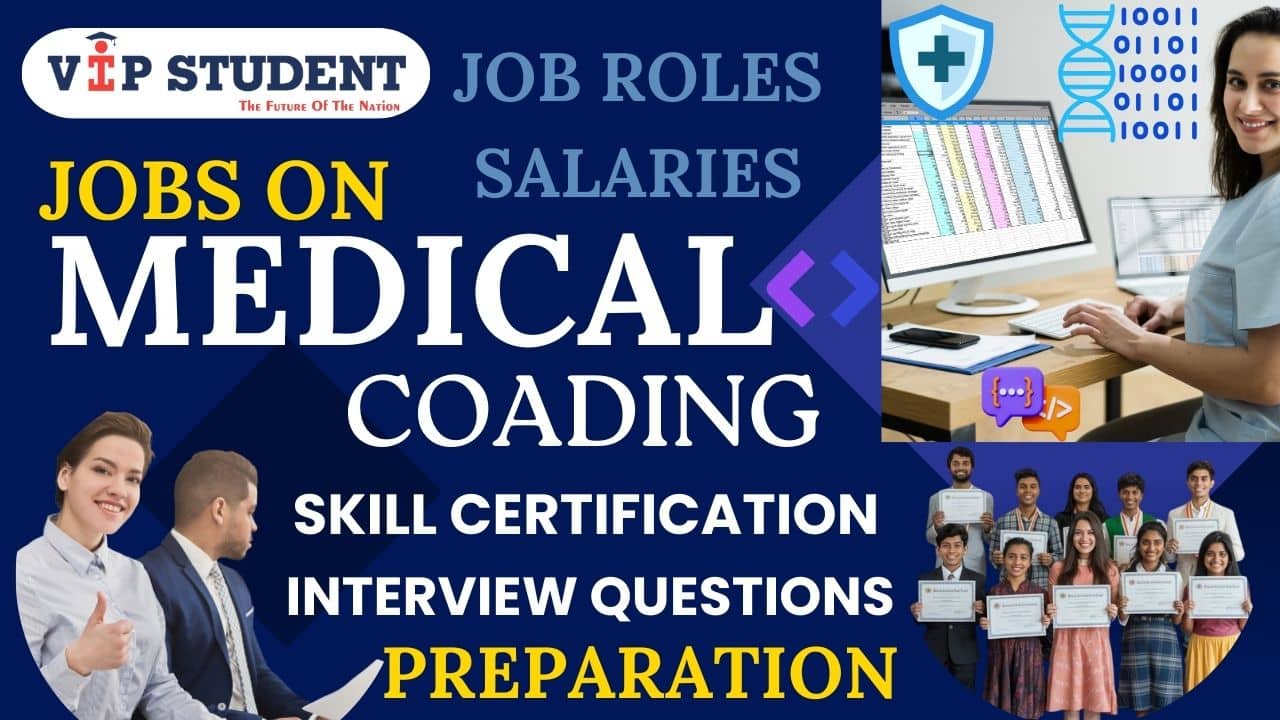LET’S KNOW ABOUT MEDICAL CODING JOB ROLES, REQUIRED SKILLS,SALARY PARTICULARS, PRACTICE JOB INTERVIEW QUESTIONS AND GET CERTIFIED ON YOUR MEDICAL CODING SKILLS
MEDICAL CODING JOBS: The Indian healthcare industry is growing at an unprecedented pace, driven by increased demand for quality healthcare, insurance penetration, and digital transformation. One of the fastest-growing career paths in this ecosystem is medical coding. Though behind-the-scenes, this profession is crucial for the smooth functioning of healthcare revenue cycles.
Whether you’re a job seeker or a student planning your career let’s know about Medical Coding job roles, required skills, practice on job interview questions and get certified on your Photoshop – Video Making skills.
JOBS ON MEDICAL COADING SKILLS AND CAREER OPPORTUNITIES
Medical coding is the process of converting a patient’s medical reports, diagnoses, treatments, and procedures into standardized codes. These codes are used for billing, insurance claims, and maintaining electronic health records (EHRs). Medical coders refer to clinical documents and assign codes using standard coding systems like:
- ICD-10 (International Classification of Diseases)
- CPT (Current Procedural Terminology)
- HCPCS (Healthcare Common Procedure Coding System)
In India, coders often work with US-based healthcare clients, processing patient data for insurance claims and compliance. The demand for medical coders in India is growing for several reasons:
- The growth of medical billing outsourcing by US hospitals and insurance companies to India
- Increasing digitization of health records (EHR adoption)
- Expanding private healthcare sector and insurance services
- Attractive work-from-home or remote job options
- Short-term training and certification paths (no medical degree required)
India has become a global hub for medical coding and billing due to its trained English-speaking workforce and cost-effective services.
1. Medical Coder (Fresher or Junior Coder)
Most professionals start their career as junior medical coders.
Key Responsibilities:
- Review clinical documents and discharge summaries
- Assign ICD, CPT, or HCPCS codes
- Ensure accuracy and adherence to guidelines
- Collaborate with team leads and quality analysts
Typical Salary: ₹2.0–3.5 LPA for freshers
2. Senior Medical Coder
With 2+ years of experience, you can advance to a senior coder role.
Key Responsibilities:
- Handle complex coding scenarios
- Assist in audits and quality checks
- Guide junior coders
- Update coding based on client feedback
Typical Salary: ₹4.0–6.5 LPA
3. Quality Analyst (QA) / Coding Auditor
This role focuses on maintaining coding accuracy by reviewing the work of other coders.
Key Responsibilities:
- Audit coding reports
- Ensure compliance with international standards
- Train coders on new guidelines
Typical Salary: ₹6.0–8.0 LPA
4. Team Lead / Coding Manager
Leadership roles that oversee a team of coders and ensure project delivery.
Key Responsibilities:
- Team management and project coordination
- Client communication and feedback
- Compliance and performance tracking
Typical Salary: ₹8.0–12.0 LPA and above
5. Medical Billing and AR Specialist
Closely related to coding, these roles involve submitting claims and managing insurance payments.
Key Responsibilities:
- Submit coded data for billing
- Handle rejections and denials
- Follow up with insurance companies
Typical Salary: ₹3.0–5.5 LPA
6. Remote/Work-From-Home Medical Coder
With the digital shift, many Indian coders work remotely for US-based hospitals and medical billing companies.
Advantages:
- Work flexibility
- Higher income (based on international clients)
- Better work-life balance
Where Do Medical Coders Work in India?
Medical coders in India are primarily employed by:
- Healthcare BPOs and KPOs (e.g., Omega Healthcare, Vee Technologies, GeBBS Healthcare)
- IT companies with healthcare clients (e.g., Cognizant, Wipro, Infosys)
- Hospitals and multi-specialty clinics
- Insurance companies
- Freelance or remote roles with international clients
Metro cities like Chennai, Hyderabad, Bangalore, Pune, Coimbatore, and Mumbai are major hubs for medical coding jobs.
Required Qualifications and Skills
Medical coding does not require a medical degree, but the following qualifications help:
Educational Background:
- B.Sc in Life Sciences / Biotech / Nursing / Microbiology / Pharmacy
- BPT, BAMS, BHMS or any paramedical degree
- Even non-medical graduates can apply with the right training
Skills Needed:
- Good understanding of anatomy, physiology, and medical terminology
- Knowledge of coding systems (ICD-10, CPT)
- Attention to detail and analytical skills
- Familiarity with coding tools like EncoderPro or 3M
- English proficiency and computer skills
Medical Coding Certifications in India
While some companies provide on-the-job training, having an international certification greatly boosts your career prospects and salary. Top certifications include:
- CPC (Certified Professional Coder) – AAPC
- CCS (Certified Coding Specialist) – AHIMA
- CRC (Certified Risk Adjustment Coder)
- COC (Certified Outpatient Coder)
Cost of certification: ₹25,000–₹40,000 approx.
Training duration: 3–6 months (Many training institutes across India (both online and offline) offer certified courses, including mock tests and job placement support.)
Salary Expectation Particulars on Medical Coading Job Roles
| Role | Experience | Salary Range |
|---|---|---|
| Junior Medical Coder | 0–1 year | ₹2.0–3.5 LPA |
| Senior Coder | 2–4 years | ₹4.0–6.5 LPA |
| Coding Auditor | 3–6 years | ₹6.0–8.0 LPA |
| Team Lead | 5+ years | ₹8.0–12.0 LPA |
| Remote US Client Role | Varies | ₹5.0–15.0+ LPA |
Certified coders and those working for US clients remotely often earn significantly more.
Future Scope and Growth in India
The medical coding industry in India is expected to continue growing rapidly due to:
- Rising medical outsourcing from the US
- Increased health insurance coverage in India (Ayushman Bharat and private insurers)
- Digital health transformation under India’s National Digital Health Mission
- Demand for coders in telehealth and online health platforms
GENERAL JOB INTERVIEW QUESTIONS AND ANSWERS ON MEDICAL CODING
1. What is medical coding?
Medical coding is the process of translating diagnoses, procedures, and medical services into standardized alphanumeric codes used for documentation and billing.
2. What are ICD-10, CPT, and HCPCS codes?
ICD-10 is used for diagnoses, CPT is for medical procedures, and HCPCS covers services and supplies not included in CPT.
3. Why is medical coding important in the healthcare industry?
It ensures accurate billing, helps in data analysis, supports healthcare planning, and enables insurance reimbursement.
4. What qualifications are required for a medical coding job in India?
A degree in life sciences or related fields is helpful, and certification like CPC (AAPC) or CCS (AHIMA) is preferred.
5. What is the difference between inpatient and outpatient coding?
Inpatient coding uses ICD-10-CM and ICD-10-PCS for longer hospital stays, while outpatient coding uses CPT and ICD-10-CM for short visits or procedures.
6. Can non-medical graduates become medical coders?
Yes, with the right training and certification, non-medical graduates can enter the field.
7. What are the roles and responsibilities of a medical coder?
A medical coder reviews patient records, assigns accurate codes, ensures compliance, and supports the billing process.
8. What is a CPT modifier, and when is it used?
A CPT modifier adds extra information to a procedure code to explain a service more accurately without changing its definition.
9. How do you ensure coding accuracy?
By cross-checking documentation, referring to coding guidelines, and staying updated with changes in coding systems.
10. What tools or software have you used in medical coding?
Common tools include 3M Encoder, EncoderPro, TruCode, and EHR systems like Epic or Cerner.
11. What is the difference between coding and billing?
Coding involves assigning codes to diagnoses and procedures, while billing involves submitting those coded claims to insurance providers.
12. How do you handle unclear or incomplete documentation?
I would query the healthcare provider for clarification and document the query for audit purposes.
13. What are the most common coding errors?
Common errors include upcoding, undercoding, wrong modifiers, and mismatched diagnoses and procedures.
14. Have you handled denial management?
Yes, I have analyzed reasons for denials, corrected coding errors, and worked on resubmitting claims to recover payment.
15. What is the role of a Quality Analyst in medical coding?
A QA reviews coded files for accuracy, compliance, and quality, and provides feedback to coders for improvement.
16. What are DRGs in medical coding?
Diagnosis-Related Groups (DRGs) are used to classify hospital cases for billing and reimbursement in inpatient settings.
17. What certifications are preferred for medical coding jobs in India?
CPC (AAPC) and CCS (AHIMA) are the most valued certifications, with additional options like COC or CRC for specialization.
18. How do you stay updated with coding changes and guidelines?
I follow official updates from AAPC and AHIMA, attend webinars, and read industry newsletters.
19. Are you comfortable working night shifts or US time zones?
Yes, I am open to working flexible shifts, including US hours, as required in outsourcing projects.
20. What is HIPAA, and why is it important in medical coding?
HIPAA is a US law that ensures the privacy and security of patient health information; coders must comply with it to protect data.
21. Have you worked on specialty-specific coding?
Yes, I have experience with specialties like radiology, cardiology, orthopedics, and emergency medicine coding.
22. What is risk adjustment coding?
It involves coding chronic and severe diagnoses to predict healthcare costs and adjust insurance reimbursements accordingly.
23. How do you manage tight deadlines and high-volume coding?
By prioritizing tasks, maintaining accuracy, and using productivity tools to streamline my workflow.
24. What are your strengths as a medical coder?
Attention to detail, thorough knowledge of coding systems, fast learning ability, and strong focus on quality and compliance.
25. Why do you want to work as a medical coder?
I enjoy working with healthcare data, and medical coding offers a stable career with continuous learning and remote work opportunities.
PRACTICAL JOB INTERVIEW QUESTIONS AND ANSWERS ON MEDICAL CODING JOB ROLES
1. What is the main objective of medical coding?
To translate clinical documentation into standardized codes used for billing, insurance claims, and statistical analysis.
2. What coding systems are you familiar with?
ICD-10-CM for diagnoses, CPT for procedures, and HCPCS Level II for equipment and non-physician services.
3. How does ICD-10-CM differ from ICD-10?
ICD-10-CM includes clinical modifications specific to diagnoses and is used in outpatient settings, especially in the U.S.
4. What is CPT and why is it used?
CPT (Current Procedural Terminology) is used to code medical, surgical, and diagnostic services.
5. What are HCPCS codes used for?
To code services not covered in CPT, such as ambulance rides, prosthetics, and some medications.
6. Explain how you handle a chart with incomplete documentation.
I would query the provider for clarification before assigning a code, ensuring compliance and accuracy.
7. What is upcoding?
Upcoding is assigning a higher-level code than justified by the documentation, which can result in penalties and audits.
8. How do you stay compliant with coding regulations?
By following coding guidelines, payer-specific rules, and staying updated with AAPC/AHIMA publications.
9. What is meant by medical necessity?
It means the service provided is appropriate for the diagnosis and is justified by documentation and clinical standards.
10. Describe the importance of modifiers in CPT coding.
Modifiers add additional information about the service provided and clarify any special circumstances.
11. Can you give an example of when Modifier 25 is used?
Modifier 25 is used when a significant, separately identifiable E/M service is performed on the same day as a procedure.
12. What tools or encoders have you worked with?
3M Encoder, Optum360, TruCode, and web-based EHRs like Epic or Cerner.
13. How do you manage work pressure in high-volume coding environments?
By organizing tasks, using productivity tools, and maintaining focus on accuracy and turnaround time.
14. What is DRG coding?
Diagnosis Related Groups classify hospital cases for reimbursement under inpatient prospective payment systems.
15. What is the significance of NCCI edits?
They prevent inappropriate coding combinations and ensure accurate reimbursement.
16. What are LCD and NCD guidelines?
Local Coverage Determinations and National Coverage Determinations define Medicare’s payment rules for services.
17. What is HCC coding?
Hierarchical Condition Category coding adjusts risk scores based on chronic conditions for payment models.
18. How do you ensure patient data security?
By complying with HIPAA, not sharing personal information, and using secure platforms.
19. What is the process for handling a coding denial?
Identify the denial reason, correct the code if needed, and resubmit with supporting documentation or appeal.
20. How do you differentiate between outpatient and inpatient coding?
Outpatient coding uses ICD-10-CM and CPT; inpatient coding includes ICD-10-CM and ICD-10-PCS for procedures.
21. What is ICD-10-PCS?
A coding system used only for inpatient procedures, detailing the approach, body part, and technique.
22. What are MUEs in medical coding?
Medically Unlikely Edits restrict how many times a service can be reported for a patient in one day.
23. What is meant by bundling in coding?
Bundling refers to combining multiple procedures into one code, typically for payment purposes.
24. When should Modifier 59 be used?
To indicate a distinct procedural service not typically reported with another service.
25. How do you prioritize charts for coding?
Based on payer deadlines, patient status, and the type of encounter (e.g., ER, inpatient, surgical).
26. Describe your experience with coding audits.
I’ve participated in internal QA reviews, corrected errors, and incorporated feedback to improve accuracy.
27. What are diagnosis pointers?
They link specific procedures to the corresponding diagnosis codes on claim forms.
28. What is a clean claim?
A claim that has no errors or omissions and is processed without delay.
29. How do you code a bilateral procedure?
Using Modifier 50 or two separate line items with appropriate units and modifiers, depending on payer policy.
30. What are common coding errors?
Incorrect modifiers, mismatched diagnoses, undercoding, upcoding, and incorrect POS codes.
31. What is POS in coding?
Place of Service codes indicate the setting where the service was delivered, affecting reimbursement.
32. What are the levels of E/M coding based on?
Patient history, physical examination, and medical decision-making complexity.
33. How do you code preventive services?
By using CPT codes specific to screenings and physicals, along with ICD-10 codes for routine health exams.
34. Have you worked with revenue cycle teams?
Yes, to ensure claim accuracy, reduce denials, and streamline reimbursement.
35. What is a superbill?
A form used by providers to document the services rendered, which is then used for coding and billing.
36. How do you maintain productivity without compromising accuracy?
By following a workflow system, using software tools, and reviewing QA feedback regularly.
37. How do you handle vague or incomplete diagnosis terms?
Query the provider and use coding conventions to ensure specificity and compliance.
38. What is the global period in coding?
A time frame during which all related post-procedure care is included in the initial payment.
39. Describe a time you resolved a coding issue.
Once, I corrected an incorrect modifier that caused repeated denials and successfully reprocessed claims.
40. What is your average daily coding volume?
Depends on specialty; for E/M coding, around 150–200 charts per day with 95–98% accuracy.
41. What is the difference between principal and secondary diagnosis?
The principal is the main reason for the encounter; secondary includes coexisting or contributing conditions.
42. What does a medical coding audit involve?
Reviewing coded records to ensure accuracy, compliance, and alignment with official guidelines.
43. What does CPT Category II code represent?
Performance measurement codes used for tracking quality of care, not for reimbursement.
44. What do you know about risk adjustment in coding?
Risk adjustment accounts for patient complexity and helps in fair payment distribution in value-based care.
45. What is unbundling and why is it problematic?
Separating bundled services to increase reimbursement—considered unethical and leads to denials.
46. How do you code telehealth visits?
Using specific CPT codes with modifiers (like 95) and appropriate POS codes.
47. What steps do you take before finalizing coded records?
Double-check for completeness, correct modifiers, validate diagnoses, and ensure code alignment with documentation.
48. Have you worked on ICD-10-CM Chapter-specific coding?
Yes, including chapters like Circulatory, Respiratory, Endocrine, and Pregnancy codes.
49. What is the importance of code specificity?
It improves reimbursement accuracy and prevents denials or audits.
50. Why is continual training important in medical coding?
Coding guidelines, payer policies, and medical practices evolve—ongoing training ensures relevance and compliance.
GENERAL JOB INTERVIEW QUESTIONS AND SAMPLE ANSWERS
1. Tell me about yourself.
General Answer:
you have to tell about your self minimum 3 to 5 minits – Tell about your personal details like your name , parents and siblings and what they do , your location and its famous for, your acadamics like your school name, college name and mention marks you are obtained in 10th class, intermediate, graduation, post graduation (as per your education) and your school or college known for, your certification cources, your projects, your achivements , your tallents, your hobbies and skills you are good at like communication, problem-solving, and teamwork.
And conclude with “I’m looking forward to contributing my skills and strengths to a great/new organization while continuing to learn new skills and to develope my strengths.”
2. What are your strengths?
General Answer:
“My strengths include being organized, reliable, and a quick learner. I’m also good at working with others and staying calm under pressure.”
3. What is your greatest weakness?
General Answer:
“Sometimes I focus too much on details because I want everything to be perfect. However, I’ve been working on managing my time better and knowing when to move on to the next task.”
4. Why do you want to work here?
General Answer:
“I’ve heard positive things about the company’s culture and growth opportunities. I’m excited about the chance to work in an environment that values learning and teamwork.”
5. Why should we hire you?
General Answer:
“I believe I can bring value through my work ethic, adaptability, and eagerness to learn. I’m confident I can quickly become a productive member of your team.”
6. Where do you see yourself in 5 years?
General Answer:
“In five years, I hope to be in a position where I’ve gained more experience, taken on new challenges, and grown professionally within the company.”
7. Describe a challenge you’ve faced and how you handled it.
General Answer:
“I faced a situation where deadlines were tight and priorities were shifting. I stayed focused, managed my time well, and communicated clearly with my team, which helped us complete the project successfully.”
8. How do you handle stress and pressure?
General Answer:
“I try to stay calm and focused by organizing my tasks and taking short breaks when needed. I also talk to teammates or supervisors if I need support.”
9. Do you prefer to work independently or in a team?
General Answer:
“I’m comfortable with both. I enjoy collaborating and learning from others, but I can also stay focused and productive when working on my own.”
10. Do you have any questions for us?
General Answer:
“Yes, I’d like to know more about the daily responsibilities of the role and what the team culture is like.”
GET CERTIFIED ON YOUR MEDICAL CODING SKILLS AND KNOWLEDGE
JOBS ON MEDICAL COADING SKILLS – Conclusion:
Medical coding in India is an excellent career option for graduates looking to enter the healthcare industry without a clinical background. It offers high job demand, good salary growth, flexible work options, and global career opportunities with the right certifications.Whether you’re a science graduate, a nursing professional, or a fresher exploring career paths, medical coding can be your gateway to a stable and rewarding future in healthcare
we hope these Medical Coding jobs interview questions are helpfull to you.Preparing for a job interview can feel overwhelming, but having thoughtful answers to common questions can make a big difference. The key is to stay confident, be honest, and tailor your responses to reflect your real experiences and goals. Use the questions and sample answers above as a guide, but remember to make them your own.






